TAPAS.network | 9 January 2025 | Commentary | Vincent Stops
Let’s put more and safer cycling in the mix with better buses and great streets for walking too

In the third and final part of his series looking at how cycling fits within wider urban transport policy thinking, advocates an approach that supports more attractive and safer cycling provision whilst also supporting better bus services and liveable neighbourhoods that encourage pedestrian activity. A balanced approach must be the aim, he believes
IN MY TWO previous articles in this series I looked at examples of where policies to accommodate and promote cycling can have other undesirable outcomes. I explored how implementing Dutch practice, if that did indeed lead to huge increases in cycling in the UK, would likely mean many more cycling casualties, and that simply installing what are loosely described as ‘protected’ cycle tracks by reallocating roadspace can significantly affect bus services, their passengers and everyone else that uses streets in urban areas.
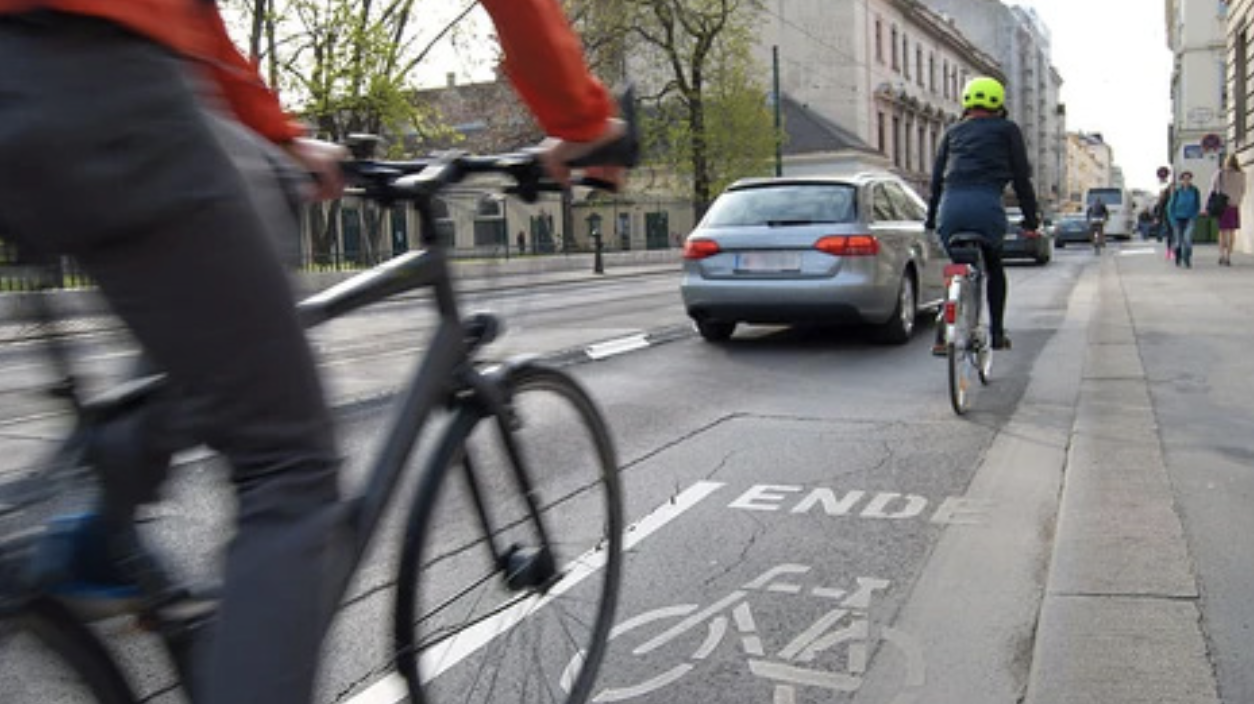
These particular concerns do not however mean that I dispute the fact that more and safer cycling is important for the healthy development of towns and cities, and so now want to explore how street management approaches are needed that support cycling, but also integrate with policies for better bus services and other sustainable modal choices whilst creating great city streets and liveable neighbourhoods.
Fundamentally we need a commitment to rigour and proper analysis of what works and might work. The present orthodoxy of the ‘new cycle activism’ proclaims ‘if you build it, they will come’. However there is little evidence to support this claim.
Cycling has certainly had a fair wind behind it in recent years. Government (most specifically the Boris Johnson led one) has even legislated for more of it. But for all of the legislation, strategies and support from Prime Ministers down, they have failed to materially move the dial. The 2023 National Travel Survey headline said:
“Cycling trip rates remained broadly similar between 2002 and 2023, with a slight increase shown in 2020.”
The DfT’s latest Cycling traffic index[1] demonstrates the extent of the failure nationally. This measures cycling traffic levels relative to March 2014, up to September 2024 (see Chart 1). And even in London, where TfL have changed the methodology for measurement of cycling (explored later in this article), increases are still on the same trend as the last two decades[2] (see Chart 2), despite significant investment in bike tracks and disruption for all the other modes, particularly, bus. Interestingly, TfL’s London household survey shows declining numbers of cycling trips by London residents[3].
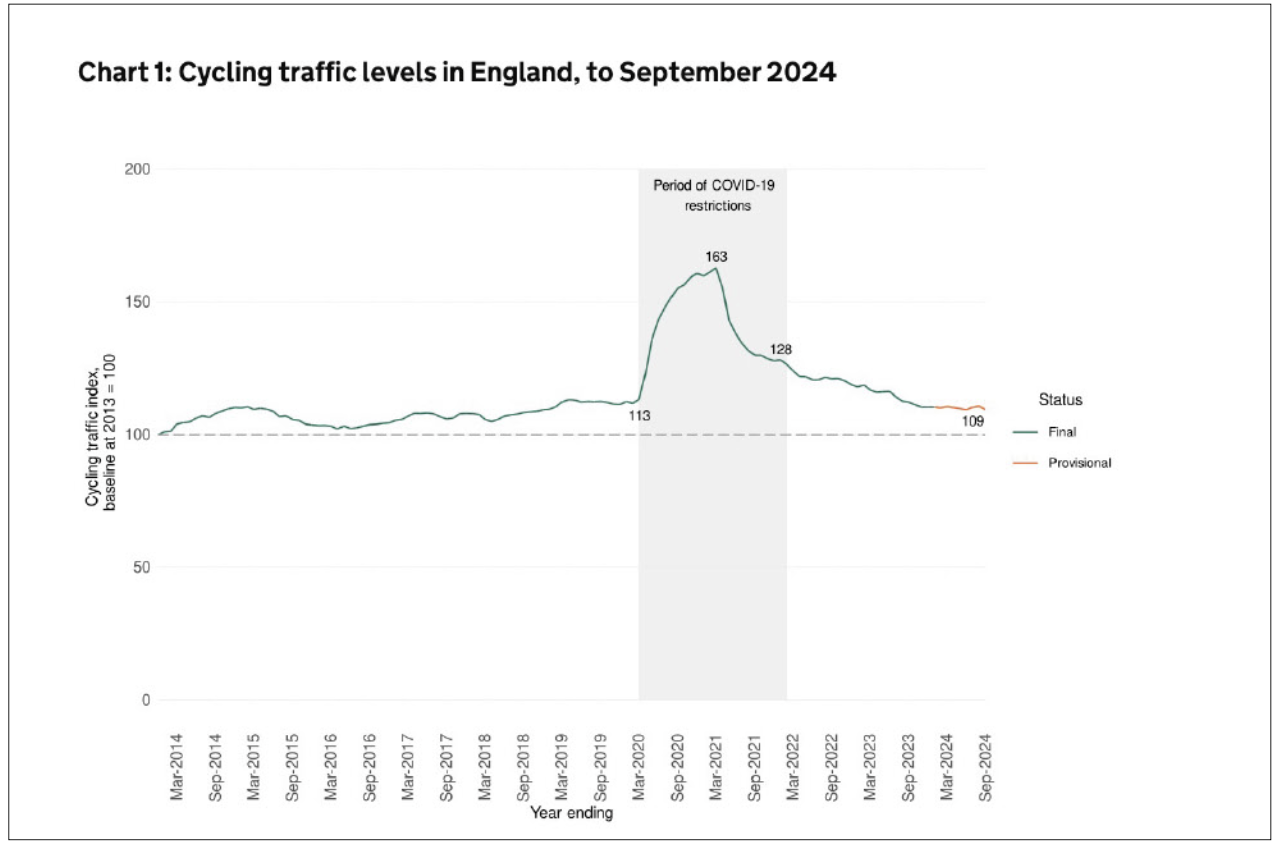
The DfT’s cycling traffic index
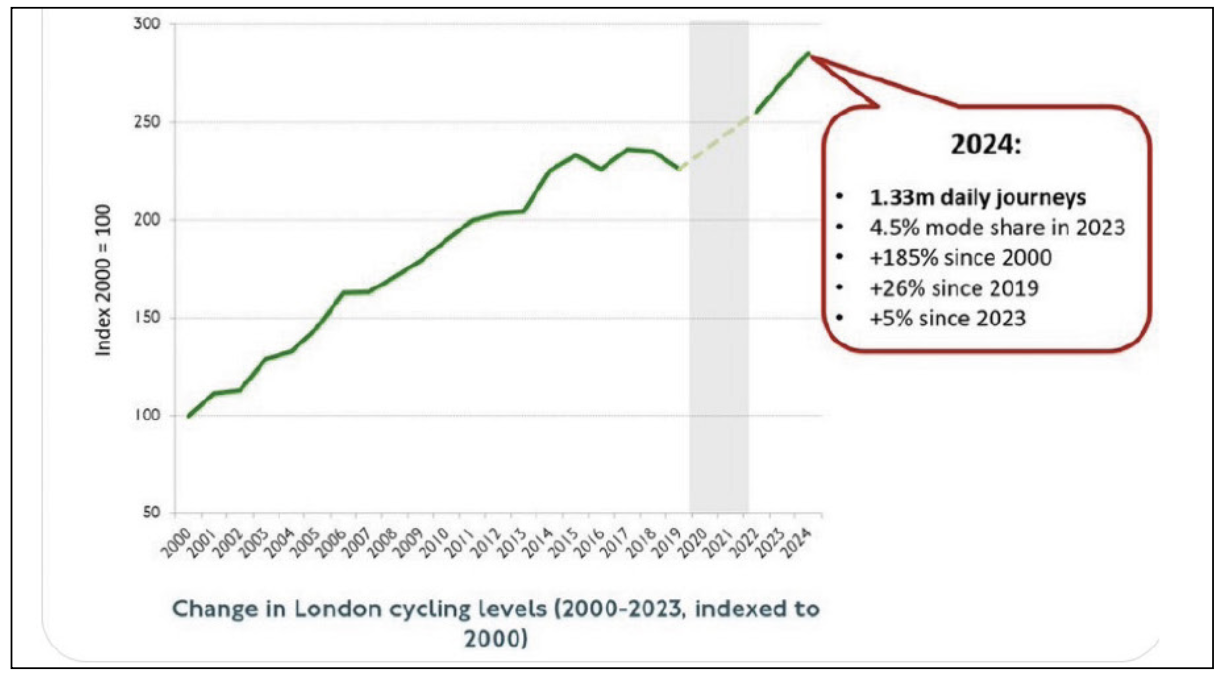
Chart 2: Changes in London’s cycling levels since 2019
NB. This data incorporates TfL’s new measure of cycling stages
And in Manchester there has been huge expenditure, a Cycling Commissioner and cycle tracks, but no additional cycling since 2016. Cycling is still just 2% of all trips in Manchester, according to the Greater Manchester Travel Diary Survey[4].
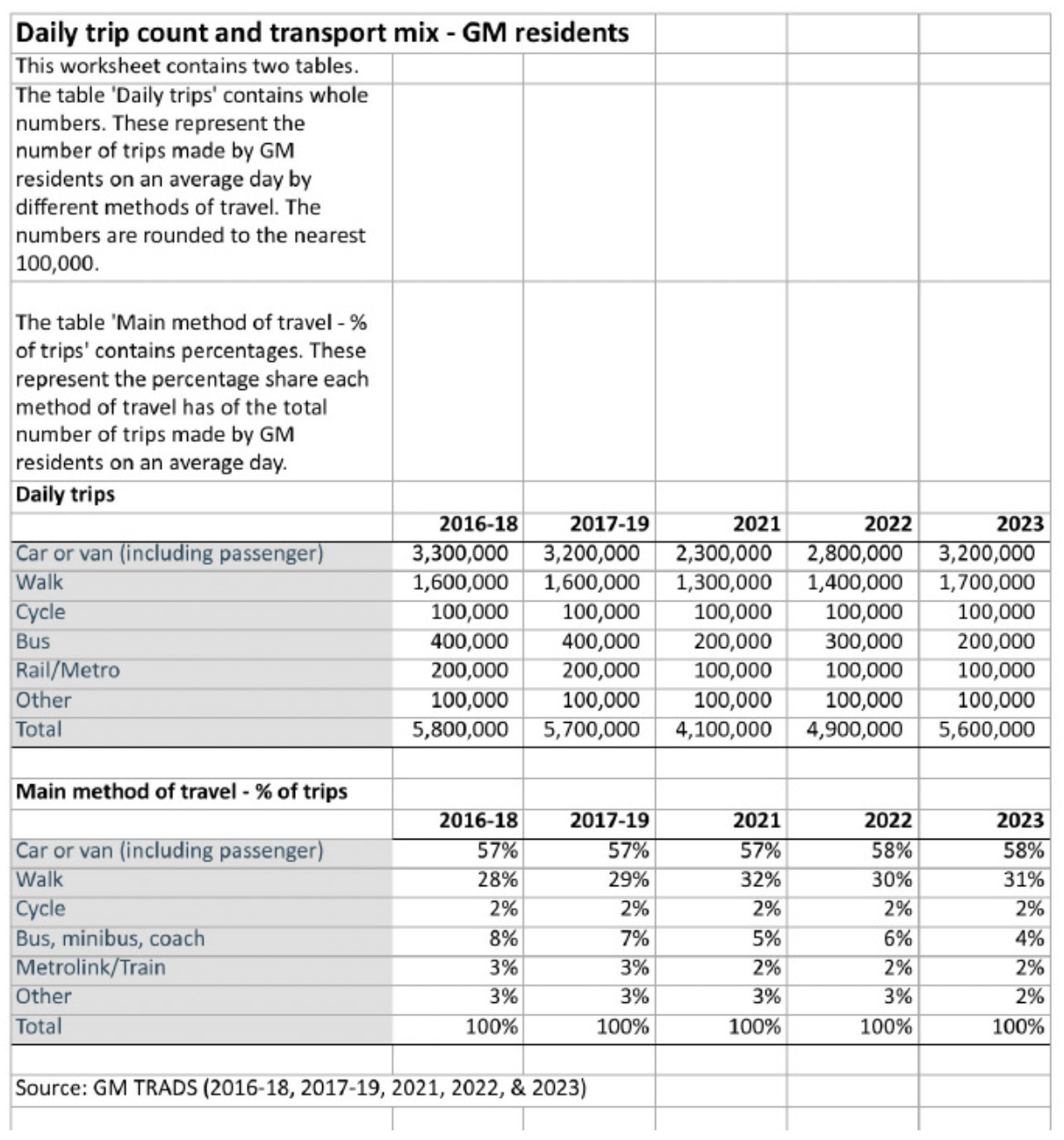
TfGM’s household travel survey
The failure of infrastructure-led changes to increase cycling levels isn’t a recent discovery. The new town of Stevenage was built in the 50’s with a Dutch model of segregated cycle tracks but, cycling levels are very low in Stevenage[5].
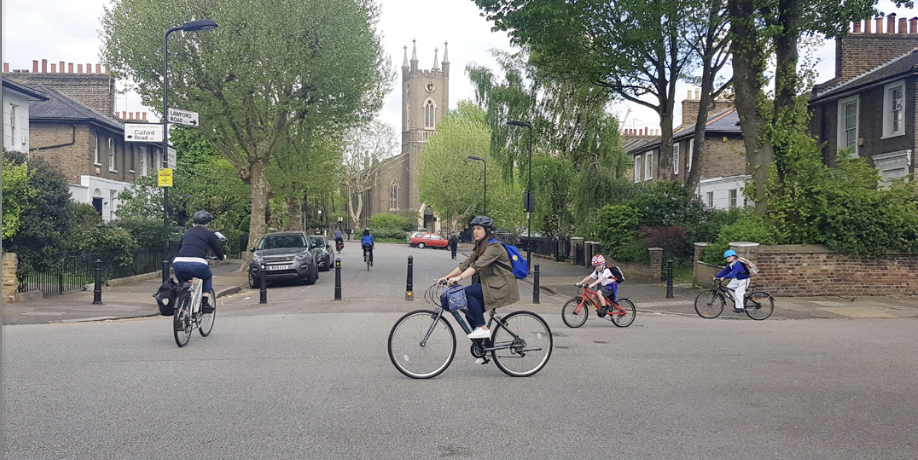
Hackney has closed streets for decades. Here to stop rat running through De Beauvoir Town
In contrast, between Census years 2001 and 2011, cycling grew far more in the London Borough of Hackney than any other local authority area in the UK - without the introduction of cycle tracks. Indeed the local cycling group resisted cycle lanes and tracks because of the problems they can cause.
Looking closely at small Census areas[6] in Hackney one can find two areas adjacent to each other, one with leafy streets, the other a high density council estate. They both share the exact same highway infrastructure, but have a sevenfold difference in cycle to work levels. On the leafy streets there was a 25% cycle to work level, on the estate just 4%! Propensity to cycling is not a function of infrastructure.
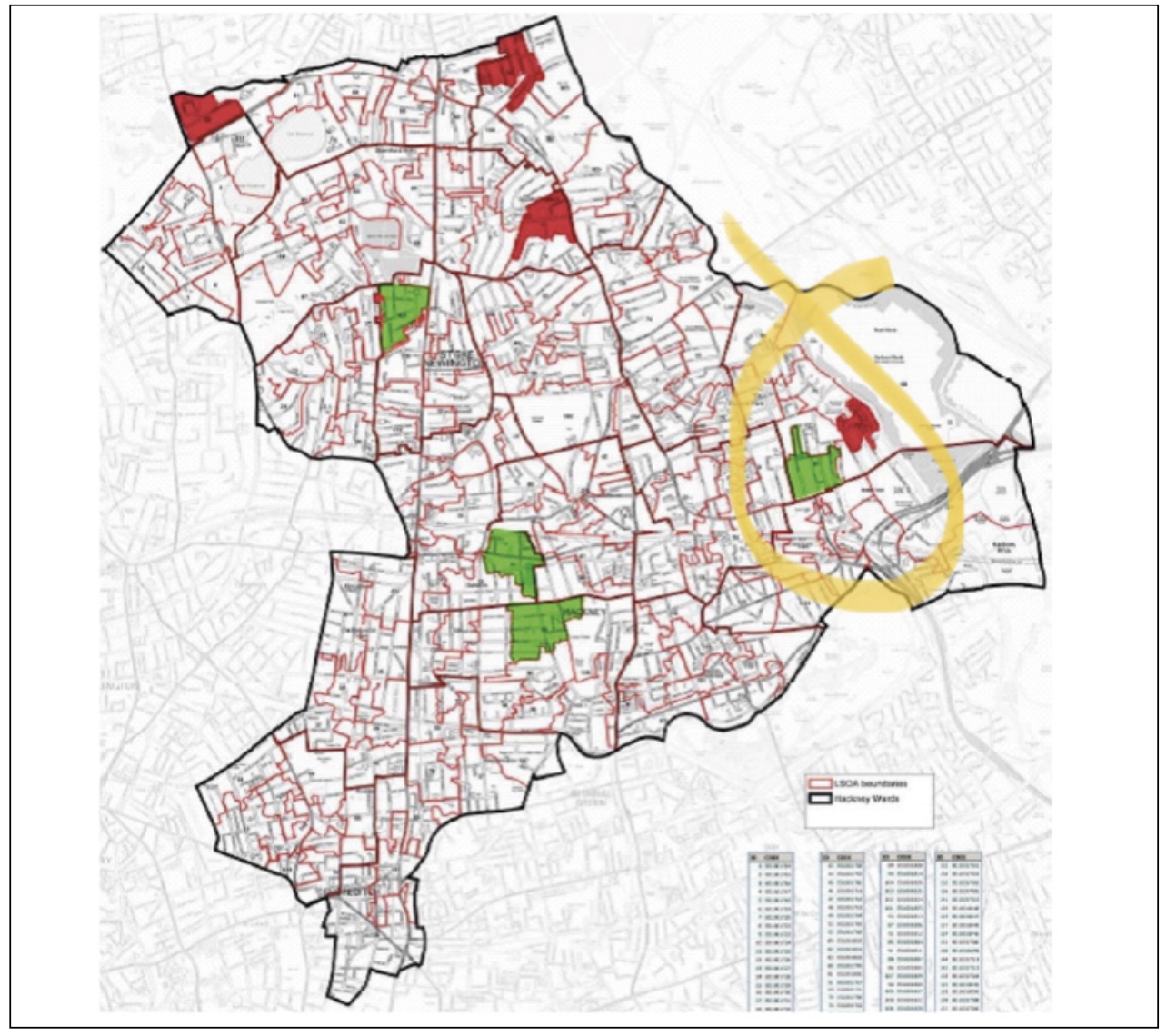
Two adjacent areas in the borough of Hackney with a sevenfold difference in cycle to work levels
It is also important to recognise that different cyclists have different needs. In his work for the DfT Simon Christmas[7] described different motivations, different barriers and different ways of cycling. Christmas makes important points:
“At the very least, infrastructure should be avoided that creates more confusion about whether, and where bicycles should be.”
“Cycling facilities can also make the road-sharing problem worse if they create additional confusion about where cyclists and drivers are meant to be…”
So what are the interventions that do get more people cycling and might also benefit sustainable transport by foot and bus? London is clearly different from any other urban area in respect of cycling propensity for a whole host of reasons, Hackney even more so. However, there are things to be learnt from its experience. Let me relate what combination of measures had an impact in Hackney between Census years 2001 and 2011 when, uniquely, more residents cycled to work than drove - some 15.6% of commuters[8].
In 2000 new London Mayor Ken Livingstone hit the ground running. Transport for London (TfL) began transforming the problematic one-way system in Shoreditch to genuinely prioritise buses, cycling, and walking. A small part of Hackney was soon incorporated into the Central Area Congestion Charging Zone, which significantly increased the number of cyclists entering the area. TfL’s analysis of the scheme’s impact revealed an unexpected 20% rise in cycling within the zone[9]. Additionally, TfL rolled out many bus lanes in Hackney as part of its flagship London Bus Initiative (LBI)[10] scheme.
Hackney meanwhile implemented a good number of controlled parking zones (CPZs). As part of the implementation process almost all pavement parking was removed. These zones reduced parking intensity and the council was able to install yellow lines at intersections, which is important for road safety, but also restrains car use by limiting trip end parking. Addressing parking stress meant that pavements became more pleasant to use for pedestrians.
Hackney Council was the first in London not only to adopt car-free planning policies in areas with on-street parking controls, but also to actively demand them of most developments. From 2004, residential off-street parking was rarely permitted. The absence of residential parking provision served as a significant incentive for residents to take up cycling, with developers required to provide secure cycle parking within their projects. To put this into perspective, approximately 1,300[11] housing units were built annually in Hackney between 2003 and 2011. Imagine the impact if even half that number of additional private motor vehicles had been introduced to Hackney’s streets.
Alongside ‘restraint’ measures, achieving slower speeds were another important initiative. We absolutely know that slower speeds deliver road safety gains, with fewer and less severe injuries. Measures included the implementation of self enforcing 20mph zones across the borough; effective side road entry treatments[12] and speed tables were introduced on many of the borough’s B roads.
Hackney had closed minor roads to through traffic for decades for various reasons. All proved to be good traffic management. In the east the Lower Clapton area had roads closed to through traffic in response to the building of the M11 in the ‘90s. The Finsbury Park road closures were, in part, to limit kerb crawling. Closures in areas adjacent to the City of London’s ‘ring of steel’ were a response to the bombing campaign of the early ‘90s, while those of the A10 ladder roads and, famously, de Beauvoir Town were targeted at rat-running. This process continued through the decade and continues now, with 70% of ‘residential’ and other minor streets closed to through traffic, some with bus gates.
It was these area wide schemes: CPZs; self enforcing 20mph zones (humps and tables) and the road closure schemes (now called LTNs- Low Traffic Neighbourhoods ) that did most to encourage and enable novice cyclists take up and stick with cycling in Hackney. Alongside these schemes there have been consistent car restraint policies: congestion charging; parking control and car-free development. And, crucially, the local cycling campaign supported shared bus/cycle lanes as important cycle infrastructure, 4.5m wide where possible.
Disappointingly, the new cycle activism now demands segregated cycle tracks adjacent to the kerb purely on the basis of motor traffic volume, regardless of kerbside access and loading requirements, even on 20mph busy high streets. These campaigns call for cycle tracks over two metres wide, routed through the footway and behind bus stops. In fact, such tracks are rarely delivered to the specified width, and many inaccessible bus stop designs leave some users unable to utilise them or feeling vulnerable when doing so.
To save space and retain limited kerbside access (such as for loading on one side of the street), TfL has ignored its own design standards[13] to fit bi-directional cycle lanes into congested urban streets with multiple side roads. Width restrictions have also led to the requirement and funding of bus stop boarders on borough roads, consequential to squeezing in a cycle lane where a bus stop bypass won’t fit, causing further challenges.
Seeking a complete network of dedicated cycle routes is anyway unrealistic. However, there are many wide 40mph roads in London which are also corridors that people might want to cycle. Kerb-separated cycle tracks and cycle-only signals could provide cycling provision along these corridors without detriment to sustainable modes. Instead, TfL has focused on measures such as removing bus lanes to introduce two-way bike tracks, for example, on Chiswick High Road.
On our busy urban streets there is just too much going on to sensibly and safely insert a separate network of bike tracks. There are too many pedestrians who want to cross informally without clambering over cycle tracks, too many older and disabled people wanting to catch their bus at a conventional stop. There is too great a demand for delivery, loading and disabled parking, too many side roads to cross and too many people just wanting to get dropped off or picked up at the kerbside. Seeking to put in cycle lanes despite these considerations is what has remarkably seen TfL allow bus performance to deteriorate. It thus has had a programme of putting in new bus lanes at the same time as taking out others, to create bike lanes!
Cycle tracks, of the sort that are now prevalent in London, may well be promoted by their advocates as safer, and even be perceived as safer, but there is little evidence that they actually are. Cycle tracks will remain problematic for cyclist safety for two broad reasons. Firstly, because they position the rider incorrectly to pass safely through junctions and across side roads, where overwhelmingly (80%[14]) of cyclist injuries occur. The rider is trapped too far left, inside of left-turning motors, to travel straight-ahead and likewise to properly position themselves early enough to turn right safely. Secondly, the intersections are more dangerous because they are more complex. Drivers and cyclists have more to process in order to navigate them. Not all users make regular journeys on the roads in question , and thus will be unfamiliar and potentially confused by them. Bi-directional cycle tracks compound the complexity.
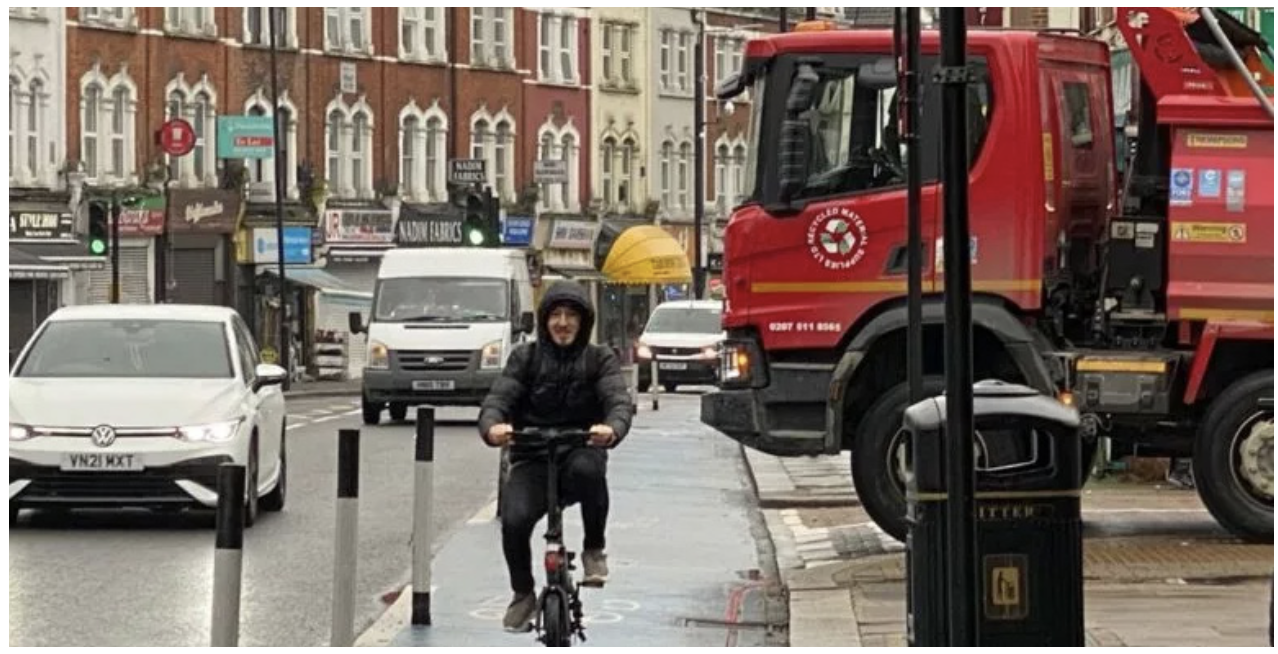
The junction of Derinton Road and Lessingham Avenue on the A24 in Tooting is said to be the most dangerous for cyclists in London
Ironically, the first Cycle Superhighway in London, number 7, along the A24 in Tooting has two simple side roads, Derinton Road and Lessingham Avenue (pictured above), that are now said by the London Cycling Campaign (LCC) to be the most dangerous junction in London, having far more casualties after the introduction of light segregation (plastic bollards) in mid 2020[15]. Similarly, Royal College Street in Camden, once an LCC award winner, is now judged by LCC to have the 8th most dangerous junction in London. Again a side road!
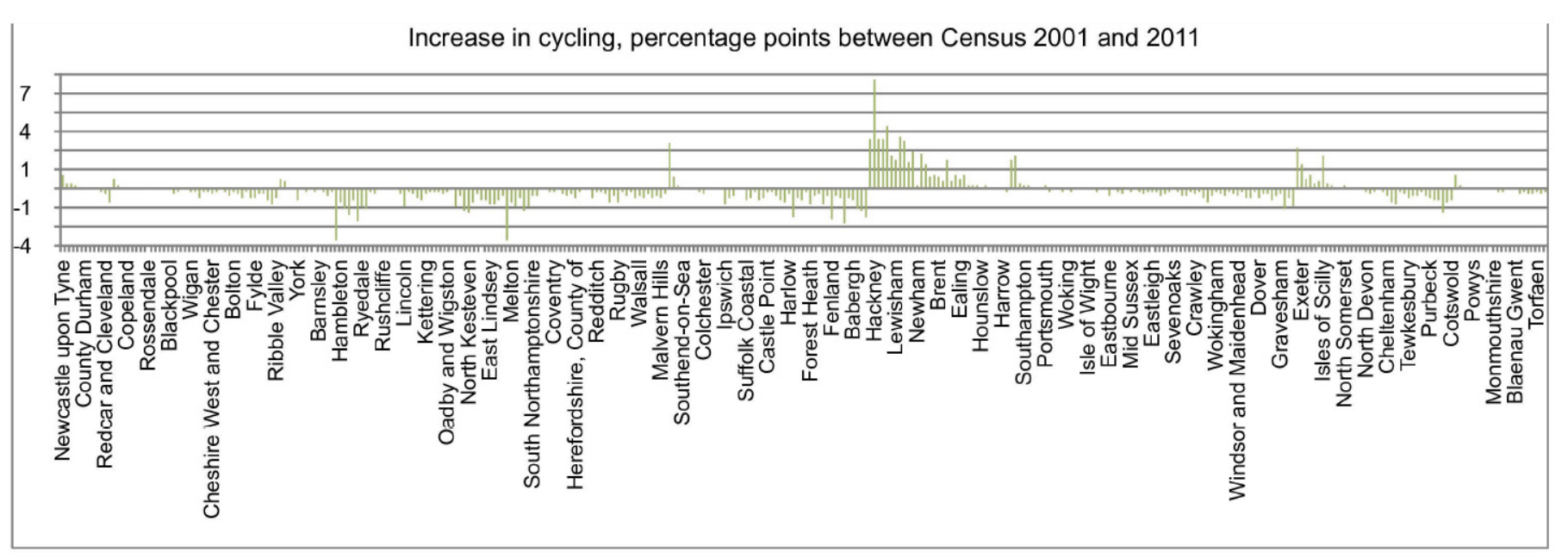
Cycling more than doubled between 2001 and 2011 in Hackney
Better solutions
Despite all the foregoing challenges, lots can be done, however, to reduce cyclist injuries on main roads. Slower speeds initiatives are really important, though self enforcing measures are difficult to implement on main roads. 20mph signed speed limits have some benefit, but enforcement would undoubtedly have more impact. Why do we campaign for 20mph, but allow 30mph limits to remain unenforced? The police have many competing priorities, but the absence of active road policing is nothing short of criminal when we are promoting the use of the roads by the vulnerable modes.
As stated above, it is at intersections where the vast majority of cycling injuries occur. London’s previous strategy of targeted engineering at these and other high risk locations was, in large part, responsible for reducing the risks of cycling in London. However, the approach at that time considered all users of the street in the solution, rather than a single focus on how to insert cycle tracks into what are already a complex layouts. Junction schemes seem now more of an art than a science with some really strange designs like those at Blackhorse Road and Elephant and Castle (see picture below), as examples. These schemes turn roundabouts into confusing U-bends, ban turns and even use the pavement as an extension of the carriageway. We are ignoring the Simon Christmas maxim of intuitive and understandable layouts.
Stopping through traffic, as part of area wide road closure schemes (aka LTNs) will reduce the number of turning movements and collisions at side roads along urban main roads and has multiple other benefits. But this must be done as part of an overall strategy for area-wide traffic management and neighbourhood environmental quality, not as has happened since the pandemic as one-off interventions, because otherwise some traffic will inevitably re-route and impact bus services.
On busy urban streets there is meanwhile often a legitimate demand to retain provision for on-street loading and even short term parking, but why residential parking is not removed to improve bus operation and general safety on critical sections of road is incomprehensible.
Bus lanes can actually make for good cycle provision too, though I know the new cycle activism protests that cycling in bus lanes is scary for some. Wide inside lanes and bus lanes (4.5m) are surely better than 1.5m cycle tracks, and allow cycles to safely pass buses and buses to safely pass cycles.
Cycling is undoubtedly an important element of the transport mix in many places, and may be increasing steadily from a low base at least in London[16], but it must be the case that London’s 5 million daily bus stages and 7 million trips by foot a day, for example, should be given more attention, rather than being made more difficult in favour of 1.3m cycle ‘stages’ a day - see footnote of Table 2.
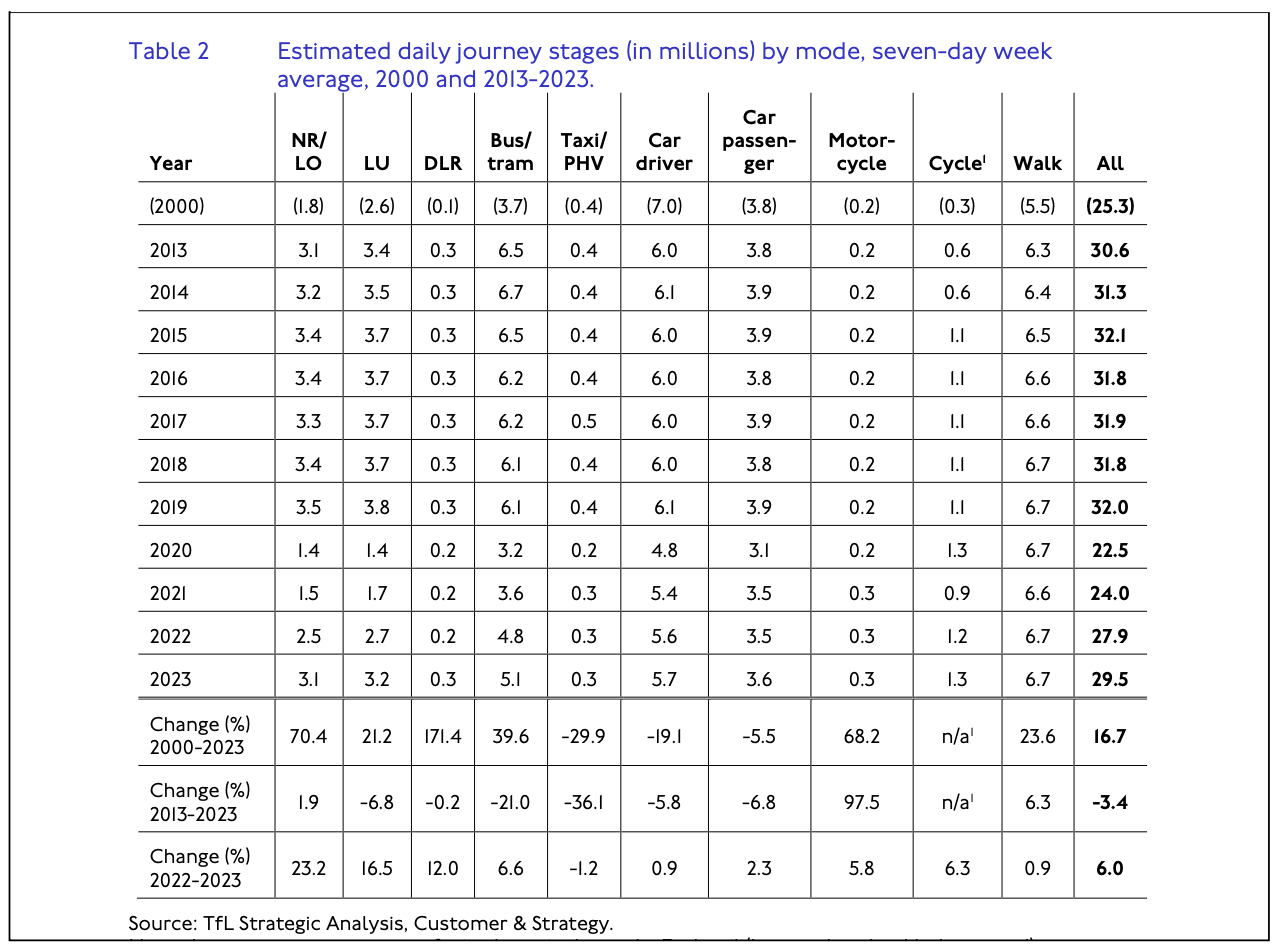
Estimated daily journey stages in London (in millions) by mode, seven-day week average. 2000 and 2013-2023
FOOTNOTE: Treatment of cycle and walking trips
In Table 2 of TfL’s Travel in London report 2024, the Bus and Cycle figures are for Stages, whereas the Walk figures are for Trips. A Trip describes travel from a substantive origin (e.g. home) to a destination (e.g. work) and records the main mode – usually the one that is used for the longest distance. Many trips involve an element of walking but ‘WALK trips’ are defined as those where it is the only mode used. A trip may comprise several stages (e.g. WALK to bus stop, BUS to station, TRAIN to another station, WALK to final destination). BUS and TRAIN are usually associated with a WALK stage at either end and may include a CYCLE stage. TfL do not make estimates of WALK stages in their published travel data, due to lack of comprehensive data. This under-representation may be a significant issue when the levels and patterns of walk activity are being considered in transport policy and practice.
The last decade has seen endless propaganda and strident claims about the case for measures to boost cycling and cycle safety, but a properly balanced perspective does not warrant just a single focus on cycling. There are substantive initiatives that can deliver a much better foundation for more and safer cycling alongside support for other sustainable modes too.
The DfT’s guidance on cycle infrastructure, LTN1/20 was produced hurriedly without consultation during the Covid pandemic , and takes too little account of the other sustainable modes. The new government should withdraw it forthwith and produce more thoughtful and thorough properly tested technical guidance on delivering balanced provision for all appropriate modes in a range of urban contexts. This is a surprisingly absent professional resource, and an urgent need.
I’d be most interested to hear from anyone who has tackled this issue of balancing the different modes in their treatment at both a policy-making and practical implementation levels.
References and Links
-
Cycle traffic index, England: https://www.gov.uk/government/statistics/cycling-index-england/cycling- index-england
-
London’s Cycling Commissioner’ Tweet, 28/11/2024
-
TfL’s Travel Demand Survey, 2023/24 https://tfl.gov.uk/corporate/about-tfl/how-we-work/planning-for-the-future/consultations-and-surveys
-
Great Manchester Travel Diary Surveys: https://tfgm.com/trads
-
Build it and they will come? Why Britain’s 1960s cycling revolution flopped: https://www.theguardian.com/cities/2017/sep/19/britains-1960s-cycling-revolution-flopped-stevenage
-
2011 Census table CT0463
-
Cycling, Safety and Sharing the Road: Qualitative Research with Cyclists and Other Road Users, DfT: https://www.roadsafetyknowledgecentre.org.uk/rskc-334/
-
Hackney is top for cyclists with more using bikes than car: https://www.standard.co.uk/news/london/hackney-is-top-for-cyclists-with-more-using-bikes-than-car-8474521.html
-
TfL’s monitoring reports of the congestion charge
-
The London Bus Initiative: https://www.lgcplus.com/archive/improving-london-buses-initiative-launched-20-03-2000/
-
Annual Monitoring reports of the London Plan: https://www.london.gov.uk/programmes-strategies/planning/implementing-london-plan/monitoring-london-plan
-
Side road entry treatments: https://content.tfl.gov.uk/effects-of-side-raised-entry-treatements-on-road-safety-in-london-final-report.pdf
-
London Cycle design Standards: https://tfl.gov.uk/corporate/publications-and-reports/streets-toolkit#on-this-page-2
-
TfL’s Cycle Safety Action Plan: https://content.tfl.gov.uk/cycle-safety-action-plan.pdf
-
Dangerous Junctions: https://lcc.org.uk/campaigns/dangerous-junctions/
-
Travel in London report 23: https://content.tfl.gov.uk/travel-in-london-2023-consolidated-estimates-of-total-travel-and-mode-shares-acc.pdf
Vincent Stops worked for 20 years as the Streets Officer at London TravelWatch, the statutory body representing transport users in London. He was also a councillor and some time lead member for transport at the London Borough Hackney, where more residents commute by cycle than drive.
This article was first published in LTT magazine, LTT906, 9 January 2025.
You are currently viewing this page as TAPAS Taster user.
To read and make comments on this article you need to register for free as TAPAS Select user and log in.

Log in